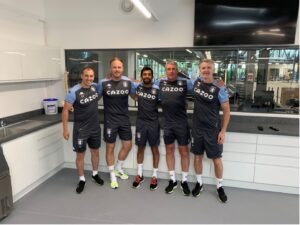The full paper can be accessed here

Tell us more about yourself and the author team.
I work as a Team Physician for Aston Villa Football Club and a Consultant in Sports and Exercise Medicine at the Royal Orthopaedic Hospital in Birmingham, UK. Steven James is a Consultant MSK and Sports Radiologist in Birmingham and one of the authors of the original papers of the British Athletic Muscle Injury Classification. Alison Rushton has recently moved to the School of Physical Therapy at Western University, Ontario, Canada as a Director, having worked very closely with the team on several projects over many years at the School of Sport, Exercise and Rehabilitation Sciences, University of Birmingham. Rajesh Botchu is a senior Consultant MSK Radiologist. Gurjit Bhogal is also a Team Physician at Aston Villa FC with lots of additional experience in cricket medicine. Kent Khurniawan works as a Sports Physician in Indonesia and joined the project whilst doing his Exercise and Sports Medicine (Football) Postgraduate MSc in Birmingham. I was greatly supported by my Performance team, particularly the physiotherapists, Rob Marshall, Steve Polley, Alan Smith and John Hartley.
What is the story behind your study?
The British Athletic Muscle Injury Classification (BAMIC) has been a ‘game changer’ for many clinicians working in sport. Muscle injury grading systems had been basic for many years. Our view is that BAMIC, with its simple, logical description, has helped clinicians improve their understanding of injured muscle tissue and has had an important role in supporting effective communication between practitioners, athletes, and stakeholders.
Clinical examination and follow-up examination is the cornerstone of our diagnostic workup. Still, imaging confirmation has become extremely important for us and others working in an elite setting, and there is no rest until an MRI has been done. There is huge pressure to give precise predictions. While BAMIC and other systems may show significant differences between grades on a group level, they all have limited value for predicting a return to play on an individual level.
Despite its widespread use in elite football, I was keen to use the system to evaluate the time to return to full training in our sport exclusively. Like research, our own personal anectodical experience is that there is a large spread of return to play within each muscle injury grade and significant between-group overlap. Therefore, we set out to investigate the anatomical location and the BAMIC system to identify any other potentially relevant factors that help us refine time predictions for return to play in our injured athletes.
In your own words, what did you find?
Our study, looking at 61 hamstring muscle injuries (HMIs) over 8 consecutive seasons in elite footballers, shows that BAMIC is applicable in elite-level English football. There is an association across the grading system and in particular shows that HMIs with any degree of intramuscular tendon involvement (term ‘c’ injuries in BAMIC) is associated with prolonged time to return to full training (TFRT) compared to those without (36 v 24 days) with an increased reinjury risk (38.5% reinjury in ‘c’ injuries v 12.5% without).
Like other studies, there is considerable overlap between grading. So it was exciting to find and report increased reinjury rates to the Distal musculotendinous ‘T’ junction of the biceps femoris (DMTJ) involving both the long and short heads on MRI. Anatomical injury location is not routinely categorised by MRI classification and cannot differentiate between potentially important clinical entities. Highlighting this to our sports medicine colleagues may help refine return to play prediction beyond MRI grading systems and initial clinical examination.
What was the main challenge you faced in your study?
We recognised that our study population was small and retrospective, so a major challenge was to design and carry out a relevant study that could stand up against large research. We recognise that whilst gold standard research for muscle injury outcomes will rely on a large multi-centred collaboration, this requires a huge effort, and so, for now, we must remain open to findings of other similar work to ours and continue to allow expert opinion that challenges our current thinking of injury patterns.
One of the main challenges was designing a study that could adequately recognise different anatomical injuries on MRI. We covered this well, but research attempting to study and define the large variety of muscle injury locations will continue to be challenging. I hope that this does not hinder any progression in learning more about this subject.
If there is one take-home message from your study, what would that be?
There are two main messages. Our study reports that the BAMIC system shows significant increased TFRT and reinjury in hamstring injures involving the intramuscular tendon in elite football. We also describe the importance of recognising injury to the Biceps femoris ‘T’ junction. We found higher reinjury rates in the location. This supports other research/expert opinions and has not only whet our appetite to look more deeply into this anatomical area but other potentially unrecognized ones. Our study supports the importance of injury location and how it may help refine the wide range of return to play seen using grading systems only.